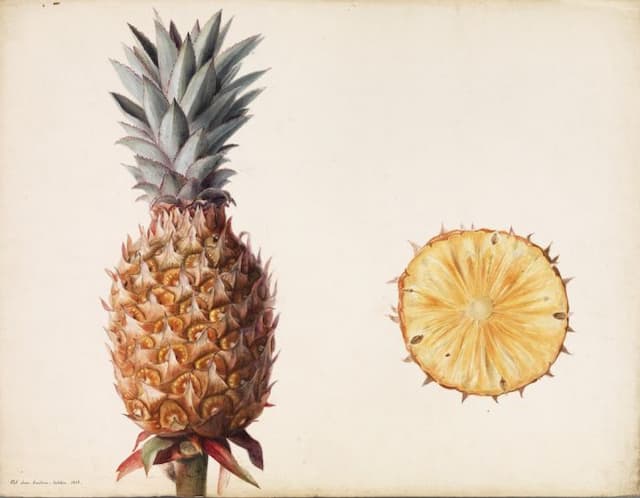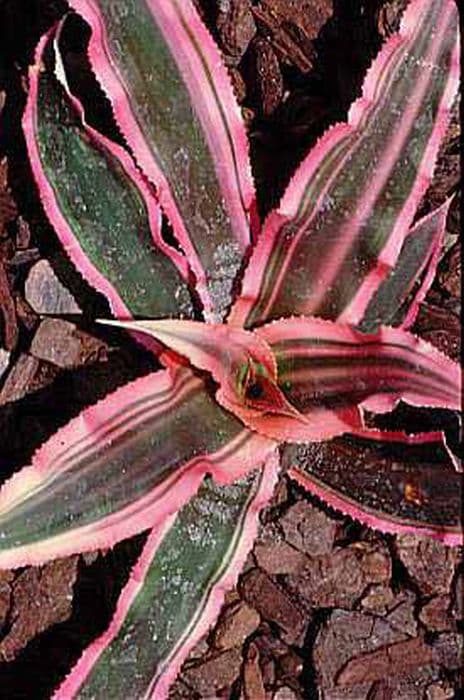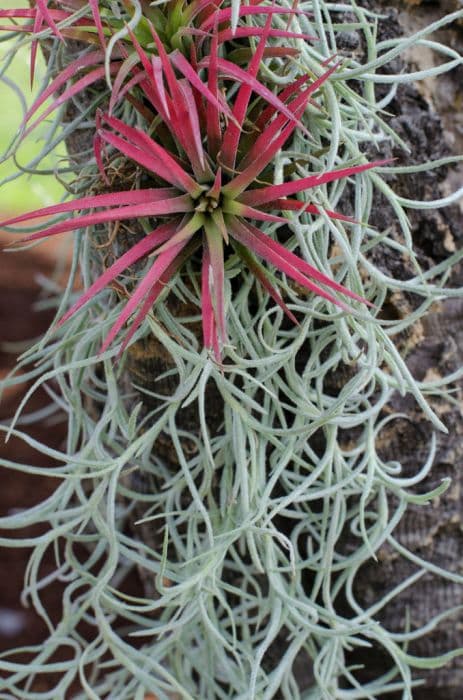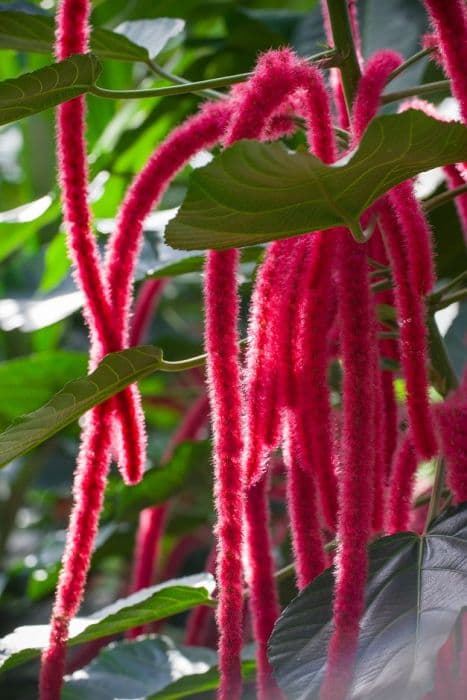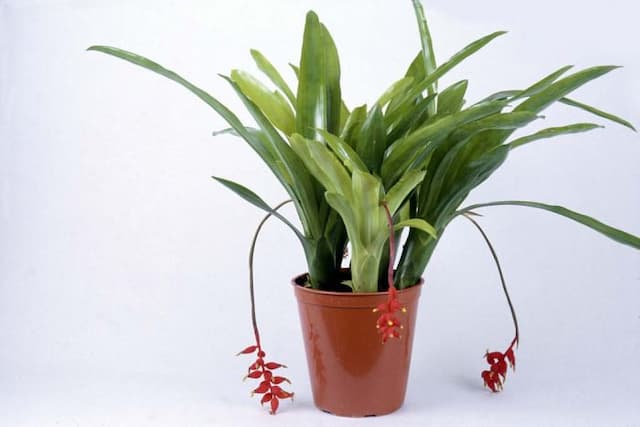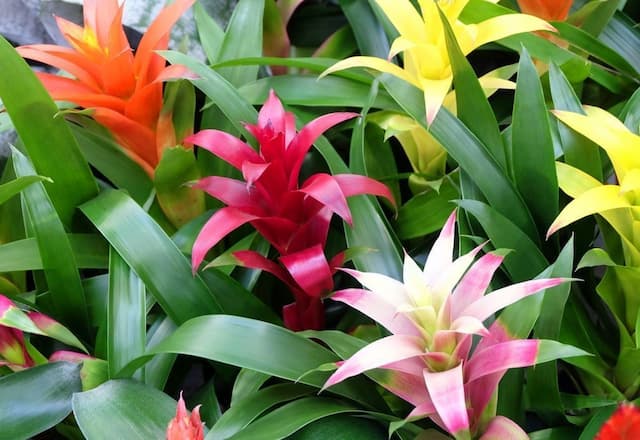Red Pineapple Ananas bracteatus

ABOUT
The plant commonly known as the "Red Pineapple" features long, arching leaves with sharp spines along the edges. The foliage showcases a variety of colors, including green, red, and sometimes variegated patterns with stripes of cream or yellow. These leaves form a dense rosette out of which emerges a central stalk bearing a unique inflorescence. The eye-catching flower head is a collection of small, vibrant blooms that can range in color from lavender to red, often surrounded by showy red bracts that can give it the appearance of a pineapple. The plant also produces fruit that resembles the common pineapple, with a rough, scale-like texture but typically not grown for consumption. The overall aesthetic of the Red Pineapple is tropical and exotic, with a bold texture and color scheme that makes it a distinctive choice for ornamental purposes.
About this plant
 Names
NamesSynonyms
Red Pineapple, Wild Pineapple, Blushing Bromeliad
Common names
Ananas bracteatus var. striatus, Ananassa bracteata.
 Toxicity
ToxicityTo humans
The Ananas bracteatus, commonly known as the Red Pineapple, is not considered toxic to humans. This plant is a bromeliad and is related to the common pineapple, which is edible. However, ingestion of the ornamental variety is not commonly reported, and consuming large quantities may cause discomfort due to the fibrous nature and potential irritation from the leaves' spikes.
To pets
The Red Pineapple (Ananas bracteatus) is not specifically listed as toxic to pets such as dogs and cats. As with humans, the plant is not typically ingested by pets, but if an animal were to chew on the leaves, the sharp edges might cause physical irritation in the mouth or gastrointestinal tract. If a pet ingests a significant amount, they might experience digestive upset, but significant poisoning is not commonly reported. If you suspect your pet has ingested parts of the plant and is showing adverse symptoms, it is best to consult a veterinarian.
 Characteristics
CharacteristicsLife cycle
Perennials
Foliage type
Evergreen
Color of leaves
Green
Flower color
Varies
Height
2-3 feet (0.6-0.9 meters)
Spread
2-3 feet (0.6-0.9 meters)
Plant type
Herb
Hardiness zones
10
Native area
Brazil
Benefits
 General Benefits
General Benefits- Edible Fruit: The Ananas bracteatus, commonly known as the Red Pineapple, produces edible fruits with a sweet and tangy flavor similar to the common pineapple, which can be used in various culinary applications.
- Ornamental Value: With its striking red color and unique bracts, the Red Pineapple adds a tropical and exotic aesthetic to gardens and indoor spaces, making it a popular ornamental plant.
- Drought Tolerance: It is a hardy plant that can withstand periods of drought, making it suitable for xeriscaping and gardens in arid climates.
- Low Maintenance: The Red Pineapple requires minimal care once established, which makes it an ideal choice for gardeners seeking low-maintenance landscaping options.
- Pest Resistance: This plant has a natural resistance to many common garden pests, reducing the need for chemical pesticides and promoting a healthier environment.
- Soil Erosion Control: The robust root system of the Red Pineapple helps to stabilize soil, making it beneficial for erosion control in areas prone to soil degradation.
 Medical Properties
Medical Properties- Anti-inflammatory: Compounds in Ananas bracteatus may have anti-inflammatory effects which could help reduce inflammation in the body.
- Wound healing: The plant has been traditionally used for its potential wound-healing properties, possibly related to enzymatic activities similar to those found in related species.
- Analgesic effects: There is some indication that Ananas bracteatus may have pain-relieving properties.
- Antimicrobial activity: Extracts from the plant have been studied for their potential to inhibit the growth of certain bacteria and fungi.
 Air-purifying Qualities
Air-purifying QualitiesThis plant is not specifically known for air purifying qualities.
 Other Uses
Other Uses- Living Barriers: Ananas bracteatus, commonly known as the red pineapple, can be planted to form dense, thorny barriers that deter intruders, both human and animal.
- Fiber Production: The leaves of the red pineapple can be used to extract strong fibers that are suitable for making textiles or crafting twine and ropes.
- Livestock Feed: In some regions, the red pineapple is cultivated as food for livestock due to its hardiness and ease of growth.
- Ornamental Use: With its vibrant flowers and unusual fruit, the red pineapple is often used as an ornamental plant in gardens and landscaping.
- Tanning Leather: The leaves of red pineapple contain enzymes that are useful in the preparation and tanning of leather goods.
- Water Filtration: The root system of the red pineapple is capable of absorbing impurities, making it helpful for natural water filtration systems.
- Compost Material: After harvest, the remaining plant material can be composted to add nutrients back into the soil.
- Culinary Accent: While not widely consumed, the fruit of the red pineapple can be used as a unique, edible ornament in gourmet dishes.
- Bee Attraction: The red pineapple is effective in attracting bees, aiding in the pollination of nearby plants and overall garden health.
- Traditional Weaving: Indigenous people have traditionally used the leaves for weaving baskets and other handicrafts.
Interesting Facts
 Feng Shui
Feng ShuiThe Pineapple plant is not used in Feng Shui practice.
 Zodiac Sign Compitability
Zodiac Sign CompitabilityThe Pineapple plant is not used in astrology practice.
 Plant Symbolism
Plant Symbolism- Wealth and Prosperity: Ananas bracteatus, commonly known as the Red Pineapple, is often associated with wealth and prosperity due to its status as an exotic, luxury fruit in the past.
- Hospitality: The Red Pineapple, as with other pineapple varieties, symbolizes hospitality and welcome, often used as a decorative motif in homes and hotels to signal guests are valued and welcomed.
- Exotic Beauty: The striking appearance of the Red Pineapple with its colorful bracts and unique structure represents exotic beauty, fascination, and uniqueness.
- Luxury: Owing to its ornamental value, the Red Pineapple can symbolize luxury and an appreciation for the finer things in life.
- Good Luck: In some cultures, the Red Pineapple is considered a sign of good luck and is used in various ceremonies and festivities to invite fortune and positivity.
 Water
WaterThe Red Pineapple (Ananas bracteatus) should be watered thoroughly when the top inch of soil feels dry, usually about once a week. However, frequency should increase to twice a week during hot or dry periods. When watering, add water until it starts to drip out of the bottom drainage holes, which may equate to approximately half a gallon for a medium-sized pot. During the winter or cooler months, reduce watering to every other week to prevent root rot. Always ensure the pot has ample drainage to avoid waterlogging which can harm the plant.
 Light
LightThe Red Pineapple plant thrives in bright, indirect light but can tolerate some direct sunlight, especially in the morning. The best spot for this plant is near a window that gets plenty of sunlight throughout the day, such as an east or west-facing window. Avoid placing it in deep shade or dark corners, as insufficient light can weaken the plant and affect its growth.
 Temperature
TemperatureThe Red Pineapple prefers warm environments with temperatures ideally between 65°F and 85°F. It can survive in temperatures as low as 60°F but should not be subjected to temperatures below 50°F to prevent cold damage. Keep the plant away from drafts and sudden temperature fluctuations to maintain its health.
 Pruning
PruningPruning the Red Pineapple plant is mainly for removing old or dead leaves to maintain its appearance and health. It's best to prune in the spring or early summer, which can encourage new growth. Pruning is not frequently required but should be done as needed, typically once or twice a year, using clean, sharp scissors or pruning shears.
 Cleaning
CleaningAs needed
 Soil
SoilRed Pineapple (Ananas bracteatus) prefers well-draining soil high in organic matter with a slightly acidic to neutral pH between 5.5 and 7.0. A good mix can be composed of equal parts peat, pine bark, and perlite or coarse sand to ensure adequate drainage. Regular feeding with a balanced fertilizer during its growing season will help maintain its health and vigor.
 Repotting
RepottingRed Pineapple should be repotted every 2-3 years or when it has outgrown its current pot. The best time to repot this plant is during the spring or summer months when the plant is actively growing. Ensure the new pot is only slightly larger than the previous to avoid excessive moisture retention that could lead to root rot.
 Humidity & Misting
Humidity & MistingRed Pineapple thrives in high humidity conditions, ideally between 60% and 80%. It is a tropical plant, so maintaining a humid environment similar to its natural habitat is crucial for its health and growth. Mist the plant regularly or employ a humidifier to achieve the desired humidity level.
 Suitable locations
Suitable locationsIndoor
Place in bright, indirect light and maintain high humidity.
Outdoor
Choose a sunny spot and protect from cold; maintain soil moisture.
Hardiness zone
10-12 USDA
 Life cycle
Life cycleThe life of the Ananas bracteatus, commonly known as Red Pineapple, begins with seed germination where the small seeds require warm temperatures to sprout. After germination, the seed grows into a small plant with spiky foliage which, over time, forms a rosette shape characteristic of adult pineapple plants. Once mature, Red Pineapple produces a flower stalk from the center of the rosette, and the flowers, which are generally purple or red, give way to a compound fruit consisting of multiple berries fused together. This fruit development process takes several months, after which the fruit ripens, showing a reddish color, and can then be harvested. Post-harvest, the plant can produce offshoots or "pups" from the base or leaf axils, which can be separated and planted to grow new plants. The original plant typically dies after fruiting, completing its life cycle, but the new pups ensure the continuation of the species.
 Propogation
PropogationPropogation time
Spring-Early Summer
Propogation: For the common pineapple (Ananas bracteatus), the most popular method of propagation is through the removal and planting of the crown. This involves cutting the leafy top off of a mature pineapple fruit and allowing the cut end to dry for a day or two. Once the end has calloused slightly, the crown is planted into a well-draining potting mix, typically at a depth of about an inch (2.54 cm, 25.4 mm). It's important to avoid burying the crown too deeply to prevent rot. The soil should be kept moist but not waterlogged, and the plant should be placed in a warm, bright location to encourage rooting, which may take several weeks. Once roots are established, the pineapple can be treated as a normal potted plant and will eventually produce its own fruit.
